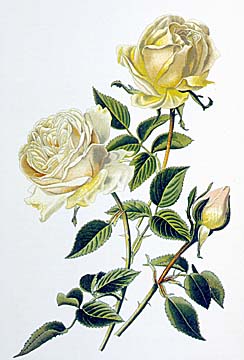Advertisement - Click to support our sponsors.


Dig This![]()
Friday, July 28, 2000

By Craig T. Kojima, Star-Bulletin
Ernest Tsang, left, and Alan Deng of Scout Troop 42 help
dig a trench at Mission Houses Museum for a rose garden.
A plot of old garden roses will soon brighten Mission Houses Museum's efforts to recreate a touch of 19th-century New England in the midst of 21st century Honolulu. New home
for old rosesWhen the missionaries arrived on Hawaii's shores, they brought with them a strong nostalgia for a home far away. The architectural style of the mission buildings reflects some of their effort to surround themselves with the familiar, but that effort continued on the grounds of the mission. According to letters found in the museum's archives, the property was landscaped with snow drops, larkspurs, Johnny jump-ups, lilies and garden roses.
Missionary Emily Ballard Dole wrote in a 1841 journal entry, "I shall spare no effort to cultivate them for of all flowers, 'the rose' has peculiar charms for me."
The Honolulu Rose Society is among the museum's partners in the garden project. Members helped the museum with research and have so far acquired four of the 20 rose varieties mentioned in archival letters.

"There are several of us in the club that like old roses," said member Margie Tanimoto. "We've done research on them, we grow them." She said their progress in tracking down these rose varieties, which were grown at the mission from the 1820s to the 1870s, speaks to the quality of the plants. "If it's still available in commerce today, then you've got to believe that it was strong enough or loved enough to survive over time," she said.Tanimoto is babysitting the first 15 plants donated to the museum and she helped decipher the letters and track down the proper plants.
Deciphering letters was a challenge in part because styles of lettering were different than they are today.
"We had to put every letter apart and try to figure out what it meant," she said. For example, she spent some time trying to find a variety called "Garcine" before realizing it was really "La Reine," still a common garden rose.
Of the 20 known to have been growing at the time, the society has identified 16 old rose varieties.
Boy scouts from Troop 42 have been invaluable in getting the rose garden started, according to museum Curator Stuart Ching.
Ching's assistant, Tory Laitila, is assistant scoutmaster for the troop, which is led by Francis Mau. The boys recently cleared the future rose bed of palms and pomegranate; digging and filling a 2-foot-deep, 60-foot-long trench, and turning in a mix of soil, compost, mulch and fertilizer. "It was a lot of hard work," said Ching.
Brewer Environmental Industries donated compost and fertilizer for the project. But more infrastructure is needed before the roses can be planted.
"The Rose Society people will be helping us put in the irrigation" within the next couple of weeks, said Ching. Then they need to wait until the weather cools to put the roses in the ground.
The first varieties in the garden will be Autumn Damask, La Reine, Souvenir de la Malmaison and Baraonne Prevost. Tanimoto has put the bareroot plants in pots and they have been blooming.
"We have seen what the flowers look like," she said.
Souvenir de la Malmaison, for example, is abundant with pink flowers and does well in Hawaii's climate, she said. It has the loose petal form and distinctive fragrance typical of old garden roses. And while Souvenir is not an overly large shrub, the letters cite other roses in the garden that grew to 10 feet and more. "There are roses that they were growing that can cover a house," said Tanimoto.
Some of the old roses are harder to grow than others, she said, and the missionaries also had to figure that out. "Not all of them thrived in Honolulu because we don't have the climate of the East Coast."
Tanimoto gives the mission women a lot of credit for maintaining a garden at all. The archives suggest the area around the mission was much more arid then. And they had to haul in water manually. But she speculates that many of the pests rose growers have to contend with now, beetles for one, may not have been in Hawaii at the time.
"It's been a very interesting project," said Tanimoto. "Through the roses, they have tried to perpetuate history.
"We're hoping that enough people will have interest in perpetuating it so they'll want to contribute to the cause."
Other project supporters include the Aloha Garden Club and the Garden Club of Honolulu. More help is needed to reach the museum's goal of restoring all 20 rose varieties to the garden. To lend a hand, call Ching at 531-0481.
Gardening Calendar in Do It Electric!
Stephanie Kendrick's gardening column runs Fridays in Today.
You can write her at the Star-Bulletin, P.O. Box 3080, Honolulu 96802
or email skendrick@starbulletin.com